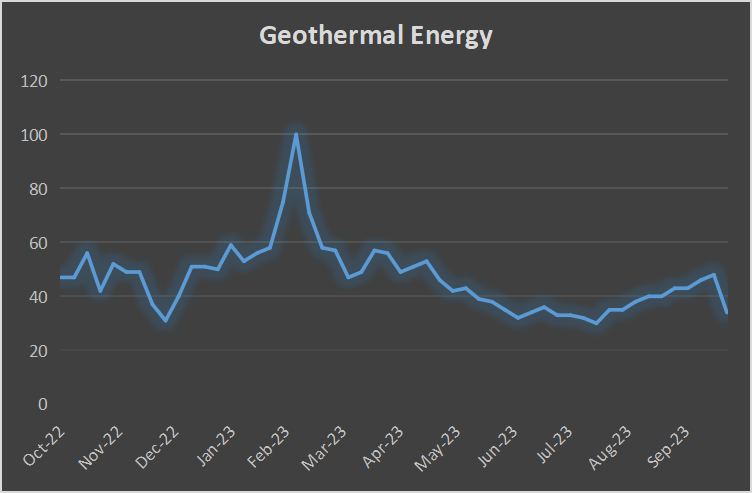Trends
Why is Geothermal Energy losing traction?
Introduction
Geothermal energy is the thermal energy generated and stored underneath the earth’s surface and has been used for centuries as a renewable source for electricity generation and direct heating applications. However, after a period of strong growth, geothermal power capacity expansion has slowed over the last decade.
Geothermal energy harnesses the earth’s naturally occurring heat in the form of hot water or steam reservoirs deep underground. Wells and pipelines bring this geothermal fluid to the surface to power turbines and generate electricity, or provide direct heating for homes and industries.
While growth reached 5% annually from 2005 to 2010 as geothermal expanded globally, capacity additions have slowed to an average of 0.7% over the last 5 years. High upfront costs, project risks, grid accessibility challenges and extensive lead times have hindered wider adoption.
However, the geothermal sector is primed for new growth with rising energy demand, technology improvements, new government incentives, and a huge untapped global resource potential. Costs are falling and major untapped reservoirs have been identified worldwide.

Current State
Geothermal energy currently plays a small but growing role in the global renewable energy landscape, supplying around 17 gigawatts (GW) of installed electricity generation capacity as of 2021. While geothermal accounts for less than 1% of worldwide power production, adoption has been steadily increasing over the past two decades.
The United States leads the world in geothermal capacity with over 3.7 GW installed as of 2020. Other top-producing countries include Indonesia, Turkey, New Zealand, Kenya, the Philippines, Iceland and Mexico. Europe has over 2 GW of geothermal, led by Turkey and Italy. The Asia Pacific region follows with about 1.7 GW of capacity, where Indonesia and New Zealand dominate.
Hydrothermal resources are the most commonly utilized for geothermal power production globally. High-temperature hydrothermal systems are used for conventional dry steam and flash power plant designs, which make up over 60% of worldwide capacity. Lower temperature resources are best suited for binary cycle plants, which contribute about 40% of installed capacity.
Despite this gradual growth pattern, geothermal power has faced limitations preventing more rapid global adoption. The foremost barrier is the high upfront costs associated with resource exploration, drilling, and plant construction. Geothermal systems are also site-specific, so reservoirs can deplete over decades of operation. Plants are often located in remote areas, requiring expensive grid connection infrastructure. Permitting and licensing processes are slow due to environmental assessments. These challenges have hindered geothermal growth outside of a few favorable markets. Continued technology improvements, cost declines, and supportive policies will be needed to unlock geothermal’s full potential.
Trends

Upward Trajectory for Geothermal
While geothermal power has faced growth constraints, recent technology improvements, cost declines, supportive policies, and vast untapped potential signal an upward trajectory for the sector.
Drilling and exploration account for the largest share of geothermal costs. But these expenses are decreasing as technologies advance, including directional drilling, better resource mapping, and higher temperature drill bits. Operations and maintenance costs are also declining with improved power plant equipment reliability.
Many governments are introducing financial incentives and streamlining permitting to spur geothermal development. Renewable portfolio standards and carbon pricing help improve geothermal’s competitiveness. Countries leading in geothermal adoption, like Indonesia and Kenya, have implemented policy frameworks to attract investment.
Emerging technologies are expanding geothermal opportunities globally. Enhanced geothermal systems can tap hot dry rock resources previously unviable to develop. Co-producing geothermal electricity from oil and gas fields can boost yields. Hybrid geothermal plants combined with solar PV or CSP boost capacity factors.
The geothermal electricity generation potential identified worldwide exceeds 500 GW – over 30 times current capacity. With continued exploration, new high-temperature reservoirs are being discovered across Africa, Asia, and Central America.
Forecasts predict geothermal capacity will reach around 32 GW globally by 2030. Growth will remain strong in top markets like Turkey and Indonesia. Emerging markets in East Africa, Southeast Asia, and Latin America will see expanded development. With technology improvements, supportive policies, and new discoveries, the future is bright for geothermal to deliver clean, renewable baseload power.
Conclusion
In summary, geothermal energy is a unique renewable power source that offers reliable, clean electricity and heating capabilities. While growth has slowed in recent years, geothermal stands poised for an upswing as technology improves, costs decline, policies support adoption, and untapped potential is unlocked.
Over 100 countries could provide geothermal electricity with adequate resources. As drilling techniques advance and new reservoirs are discovered, geothermal can play a major role in a diversified global clean energy mix. Policies like tax credits, streamlined permitting, and clean energy standards will accelerate growth by improving project economics.
Geothermal’s small land footprint, 24/7 operation, and flexibility to pair with other generation or heating applications make it a valuable complement to intermittent renewables and an enabler of decarbonization goals.
Challenges still exist around upfront costs, resource assessment, and site-specific factors. But the steady technology improvements of recent decades are expected to continue lowering expenses and risks. This will make geothermal cost-competitive with conventional fuels and open up new markets.
With rising electricity demand worldwide, geothermal looks poised for significant expansion. Projections estimate the industry could attract $1 trillion in cumulative investment through 2050 as capacity grows to keep pace with a global clean energy transition. The future bodes well for geothermal to deliver robust growth as an affordable, renewable baseload power solution.
